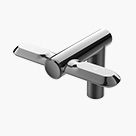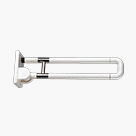Nowadays, you can find commercial hand dryers in almost every public washroom in the globe. They are a practical and eco-friendly replacement for paper towels. The hand dryer market is expected to develop significantly and see substantial innovation due to rising customer demands and technological improvements.
The newest developments in energy efficiency, improved hygiene, noise reduction, and customization—as well as their impact on the future of hand dryers—will be discussed in this article.
Efficiency in Energy
Consumers and manufacturers alike are primarily concerned with energy efficiency. Both the environment and a company’s running expenses are directly impacted by energy efficiency.
The need for hand dryers that can continue to operate at a high standard while using less electricity is therefore increasing. In response, producers are creating sophisticated versions with motors and heating systems that use less energy.
Noise Reduction:
Many manufacturers get concerned about this, as are noise-sensitive spaces like hospitals, schools, and libraries. As they get more potent and effective, they may also become noisier. Developing hand dryers with enhanced noise reduction technology is the aim of most manufacturers in an attempt to address this problem.
These advances include improved insulation, decreased air turbulence, and configurable speed settings. To further reduce noise during operation, some models even include materials designed to absorb noise inside the dryer shell. Their mission is to create a high-performing hand drier that offers the advantages of performance without compromising comfort or upsetting the neighborhood.
Customization Options:
With manufacturers providing massive alternatives to accommodate varying demands and tastes, user customization is rapidly gaining popularity among enterprises. Users may choose a hand dryer that matches the design of their bathroom thanks to the range of finishes and materials available, including chrome, stainless steel, and colored plastics.
Some manufacturers provide versions with various customizable features, such as heat, airspeed, and activation sensor adjustments. With-these settings, users may tailor the dryer to their needs and surroundings, ensuring everyone has a positive experience.
Design trends for hand dryers
One of the most significant developments in their design is-the use of touchless technology. To minimize the spread of germs and enhance general hygiene, a lot of contemporary hand dryers utilize infrared sensors to detect the presence of hands. To further assist in eliminating germs and other impurities from the air, a HEPA filter gets included in these touchless devices.
Utilizing energy-efficient technologies is another trend. In addition to being more economical and ecologically beneficial, many get made to consume less electricity than previous versions. The development of hand dryers that run on sustainable energy sources like solar or wind power is another result of this trend.
They are become increasingly adaptable and flexible in terms of appearance. Hand dryers that complement an organization’s design or logo can get chosen from various colors and finishes offered by several manufacturers. Furthermore, some may be mounted on walls or set on counters, providing additional location options.
Conclusion
Their technological and design innovations gets-aimed at providing people and organizations with more effective, sanitary, and adaptable solutions. A few instances of how hand dryer design is changing to suit the demands of the contemporary world include the shift to touchless technology and the addition of HEPA filters.


















